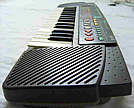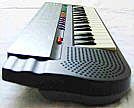 |
 |
|
 |
 |
 |
 |
The main voice sounds of the SA-35 are made from low- res samples but employ very complex envelopes. While many basic preset sounds are modelled after natural instruments, especially the 3 additional variants selected through the "tone edit" button usually do artificial modifications of them or select even a totally different sound. Typically the modifications change the volume envelope, add reverb or echo or modulate the pitch in different ways. But some presets are complex structured synth pad patterns and pulsing timbres with algorithmic envelope modifications forming repetitive sound textures those are great for tekkno trance and other meditative music.
The preset sounds are partly difficult to describe but I do my best because these include really unusual ones. In the following I indicate the "tone edit" variations with a number behind the preset name (0 = default, 1 to 3 are the "tone edit" variants). In opposite to the sound set of the Casio SA-1 family, the SA-35 presets include neither drum kits nor other key split sounds. Most default presets are like the presets of the same name on SA-1 (see there). Most have reverb, thus I mention only its absence. The "piano 1" has a slower attack rate than normal and thus sounds softer, 2 is a honky- tonk and 3 trills 2 times during attack phase. "elec piano 1" has a slower attack phase (resembles a bowed glass), 2 has strong vibrato (like a vibraphone with percussive click) and 3 trills 2 times with strong sustain (resembling a harp). "harpsichord 1" has slow attack phase (like a short pipe organ tone), 2 is short with vibrato (resembles a koto), 3 is a ringing mandolin. "elec organ" is the well known squawky Casio SA pop organ: 1 has a less percussive attack phase, 2 howls short during attack, 3 rings like a mandolin. "celesta 1" has a slower attack phase (resembles a bowed glass), 2 howls short during attack (a bit like a water droplet), 3 has 3 fast echoes when the key is held. "trumpet 1" has a decay envelope like a picked string, 2 has a delayed vibrato (more a synth violin?), 3 howls up during attack phase. "brass ens" is the famous, ridiculously static and artificial tooting Casio SA brass (with chorus but no reverb): 1 has a decay envelope like a picked string, 2 has a delayed, fast fluttering (mosquito- like?) vibrato and sounds greatly unique, 3 has a 2nd voice (5th note?, no reverb) instead of the chorus (no reverb). "clarinet 1" has a decay envelope like a harp, 2 has a delayed strong and slow vibrato (no reverb), 3 trills 2 times during attack phase with chorus. "flute 1" has a percussive decay envelope like a harp with vibrato, 2 has a detuned chorus, 3 rings like a mandolin. "harmonica 1" has a decay envelope (sounds of banjo), 2 has a delayed, fast fluttering (moskito- like?) vibrato and chorus (somewhat brassy and voice- like), 3 quickly howls up during attack. "strings ens 1" has a decay envelope (like picked string), 2 rings like a mandolin, 3 is rather a synth brass. "violin 1" trills 2 times during a fast attack phase, 2 has a detuned chorus, 3 has a bassy 2nd voice and resembles a brass ensemble with tuba (and delayed vibrato). The "cello" has a delayed vibrato and sounds brassy (like a synth tuba made from filtered squarewave); 1 has a decay envelope (like picked string), 2 has a detuned chorus with rastered vibrato (nice lo-fi bass sound), 3 has a different (brassier?) attack phase. "elec guitar" also here resembles a harp: 1 is more a flute or high human voice with slow attack phase and vibrato, 2 rings like a mandolin, 3 is a "metal guitar" that resembles more a harsh and distorted church organ or the like (major chord?). "elec bass 1" is rather a tuba or french horn with a dose of chorus, 2 trills 2 times during attack phase, 3 is a slap bass with percussive (snare- like?) clicking attack phase. "waw voice" is the well known male Casio chorus (howls up during attack phase), 1 adds a 2nd voice (5th note?), 2 retriggers the note with a slow ringing going "wah wah wah wah...", 3 is a disharmonic up and down howling and pulsing pattern of this sound. "bells 1" has a slow attack phase (resembling a bowed glass), 2 has 3 echoes after fast key release, 3 is a "Big Ben" pattern with portamento between its notes. "plunk extend" is a buzzy bubbling sort of synth e-bass which bass range reminds to a buzzing ruler: 1 howls up and down with decay envelope (short key presses sound longer because the howl repeats in the reverb), 2 slowly repeats 2 notes (like a buzzy alarm tone), 3 bubbles up while it fades quiet. "twinkle echo" is a harp with 3 echoes after key release: 1 has a slower attack rate (like a short bowed glass with echo), 2 rings like a mandolin, 3 buzzes with a fast ringing and howls up and down by 1 note (also during reverb). "jumping" is a tekkno siren with bowed glass timbre that toots and then howls and fades up while it fades silent: 1 howls down instead, 2 is a fast howling siren (like car skidding) that alternatingly switches on and off like a phone signal, with 3 the siren alternatingly howls on a low and a high center frequency with a pause in between (like an ambulance crossed with an US police car).
"car horn" toots like what the name suggests (only 1 note on all keys), 1 is higher. 2 is a "car motor" which hum turns higher, shifts gear (sounds lower again) and so on while it fades quieter (melodically playable). 3 is a great rhythmic tekkno pattern that hums (brassy?) with the car motor timbre while the pitch and timbre is irregularly modulated (key pitches are narrower than normal notes). "ambulance" toots on 2 alternating notes (melodically playable): 1 is a fast siren, 2 is a car motor like "car horn 2", but more synthetic and doesn't fade quiet. 3 rings like a mandolin on a ceramic bowl timbre. "airplane" is a propeller aeroplane timbre (with chorus) that turns higher (melodically playable), 1 is a helicopter (pitch goes slowly up and down, narrow key pitches), 2 is a tekkno siren that retriggers 2 times and goes up like a videogame effect (narrow key pitches), 3 is a slowly down and up fading, harsh and thin purring chirping (like "cosmic sound" on SA-1). "telephone" rhythmically toots slowly (ocarina timbre, narrow key pitches), 1 instead rings rhythmically (narrow key pitches), 2 rhythmically toots faster (sine wave, melodically playable), 3 is an organ tone of 2 added sine waves (5 notes distance). "chirp" is a down pitching bird tweet (short notes resemble a water droplet, narrow key pitches), 1 toots and than howls down with a fast trilling siren (a bit like the classic "Star Trek" communicator whistle, narrow key pitches), 2 resembles a synthetic human voice saying "aaoooh" (narrow key pitches), 3 is a locust chirp (narrow key pitches).
The speed of algorithmic patterns can be adjusted with the digital volume control (the quieter the faster, for technical explanation see Casio SA-1), which also changes the timbre by reducing the sample bit resolution at low volume. (The speed control capability is important to sync down the brain waves for meditation musics.) The ringing sounds (like mandolin) sound always a bit buzzy; especially at fast ring speeds they turn even buzzier because the timing flutters with strange glitches, those seem to be often caused by the chorus effect. With multiple held notes the speeds of algorithmic patterns often start to interact and synchronize with each other in interesting ways, and you can even play the same pattern with multiple speeds simultaneously by holding down a key, selecting a different volume and than pressing another key, which makes the previously held note keep its old speed and volume while new notes respond to the new volume setting. This makes of the SA-35 a perfect experimental gunk and tekkno trance instrument. The volume buttons make some annoying blip noises with different pitches, but these can be quite well hidden in the rhythm of the resulting musics.
Unlike Casio SA-1 variants, the SA-35 has only 8 preset rhythms
without accompaniment, and unlike my Casio
PA-31 here also normal rhythms reduce polyphony from 4 to 3 notes.
The other rhythms contain accompaniments those play only in a fixed- key
and can not be switched off, which severely limits their use for melody
play, and many are rather monotoes (short melody loops) than accompaniments.
Many are similar like on the SA-1 family, but there are also a few new
ones. "hopper" is a funny howling fast siren (theremin stuff) with tuba
bass, "horror" is a movie suspense monoto of a bluesy saxophone line with
chinking vibraphone and "comedy" is a nice "laughing" tuba pattern.
The instrument has a song bank of 10 wonderful orchestrated polyphonic demo melodies:
 |
 |
Technically it is likely possible to upgrade the SA-5 with 4 note polyphony and all the other features found in the Casio SA-35 because both contain the same CPU. But for this a diode would need to be soldered into the line of each key, and also the CPU needs to be switched into SA-35 mode (likely by a permanent diode somewhere in the keyboard matrix). The SA-35 contains also additionally a capacitor array (8x 100nf?) and 17x 1k resistors; I haven't examined if these have to do with the keyboard matrix or if they only improve the sample resolution. (I haven't analyzed the hardware further yet.)
Attention: Do not confuse the SA-5 with the Casio
SA-2, which has a similar case shape but contains a very crippled
Casio
SA-21 variant (with only 16 preset sounds due to omitted cipher buttons).
Fortunately the Casio SA-35 and SA-5 are not rare at all
and easy to find on eBay. Other small digital keyboards with similar
strange howling sound effects and primitive synthesizer are Bontempi
BS 2010 and
KE
3860. An FM keyboard with many algorithmic tekkno sound patterns
and synth sliders is the great Yamaha
PSS-390.
| removal of these screws voids warranty... | ||
 |
||
|
|